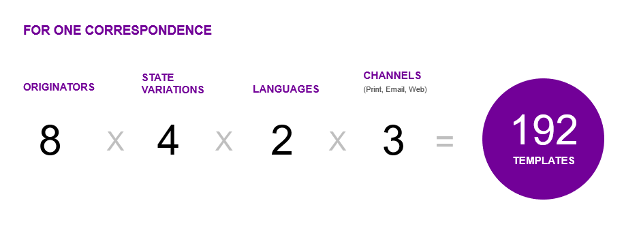
It has been almost 15 years since the global financial crisis and subprime mortgage meltdown caused a massive wave of mortgage foreclosures across the U.S. Since then, governments and regulatory institutions have made and continue to make changes to how mortgages are managed to both protect consumers and prevent another crisis. Borrower communications are an area of particular interest for regulators as they strive to ensure that consumers have the information required to understand their options and make sound decisions. One example of such is the requirement to provide borrowers with a single point of contact (SPOC) for support during loss mitigation processes. This SPOC becomes the borrower’s liaison, responsible for communicating all options, assisting with documentation, and providing all the necessary information.
The Consumer Financial Protection Bureau (CFPB), the federal agency in charge of implementing and enforcing consumer financial law, has not yet legislated specific SPOC requirements. Thus, state regulators have decided to implement SPOC measures of their own accord. This often happens when regulations are not federally controlled, and the rules vary from state to state. New York is the most recent state to introduce a SPOC requirement, with the recent passing of bill S671. This inconsistency across states creates problematic complexity and inefficiency for mortgage servicers when it comes to supporting those regulatory variations. As a result, mortgage servicers face a costly, time-consuming headache when it comes to updating their borrower communications.
Accommodating regulatory requirements in borrower communications is a complicated process for mortgage servicers. The CFPB details many requirements which apply at the federal level. But there are also state-level disclosures and regulations that add to the cost and complexity of updating borrower communications across the US.
This complexity increases when it comes to loss mitigation and the default process. It costs 13 times more to service a non-performing loan than a performing one, in part because of the increased volume and intricacy of communicating with borrowers throughout the process. Not only does the number and frequency of communications increase, but loss-mitigation communications are strictly regulated. In addition to state requirements, the CFPB has stringent guidelines for the information and language which must be included in every communication. Also, the loss mitigation process provides many avenues and options for borrowers: forbearance, foreclosure, modification, short sale, and more. The approach mortgage servicers must take to communicate with their borrowers will depend on the paths their borrowers choose.
The passing of bill S671 in New York state, which requires mortgage servicers to provide SPOC contact information within ten days of a borrower request, went into effect on January 2, 2022. Mortgage servicers will need to include specific SPOC-related language in the appropriate future borrower communications sent during the loss mitigation process. New York is not the only state to introduce this requirement. The largest mortgage servicers have special rules applied as a result of a global settlement agreement as well as large servicers participating in the Home Affordable Modification Program.
To the unfamiliar outsider, the change might not sound terribly significant. After all, mortgage servicers would only need to add a few sentences into loss mitigation communications sent to New York residents. But unfortunately, most mortgage servicers rely on outdated communications technology and processes. For them, accommodating these borrower communication changes will be time consuming and expensive.
First, mortgage servicers will have to sort through their stored library of hundreds of communication templates to identify the many pieces impacted by these changes. Each impacted communication will need to include the new official verbiage relating to timing, frequency of contact, and other measures. That includes translated documents too. Next, servicers will duplicate the impacted templates in order to draft new versions for New York’s bill S671 requirements. In short, they’ll need to create and manage a whole new set of correspondence pieces. Each new template would then need to be circulated among internal stakeholders for approval, including legal and compliance adherence. The approval process can be slow, difficult to track, and vulnerable to human error.
Finally, the approved templates will be delivered to their IT department, or third-party service provider, who will have to code each communication piece individually in a letter or document management system. This could take weeks to months depending on the provider’s availability and workload, and will be costly. After that, the new borrower communications will need to be tested. And the whole laborious process will need to be repeated across every separate communication channel. Although many mortgage servicers rely on printed communications alone, if other channels are at play such as email or a secure client portal, these will need to be updated in their separate systems.
And the update process is ongoing. Should New York amend bill S671 in future, or should another state introduce similar measures, the arduous, expensive routine will begin again. As a result, even proactive mortgage servicers might end up out of compliance with the new SPOC rules. During that time, they would be subject to fines from the CFPB. If that were to occur, they would also risk the loss of their reputation with mortgage originators.
The heart of the problem is that many mortgage servicers take a document-centric approach to borrower communications: meaning that each communication is managed as a static template. Thus, every layer of complexity – a new channel, a second language, a regulatory change — demands the creation and maintenance of a new template. For instance, if a servicer has a letter which has to be co-branded with 8 different originators, and also requires four separate state variations in two languages across three different channels, the result could be 192 separate templates. It’s easy to see how the process can quickly spiral out of control.

Mortgage servicers can end the onerous burden of the document-centric approach by conceiving of their communications in an entirely new way. In a document-centric world, every communication is built and maintained separately, even if the parts and patterns it contains are duplicated across hundreds of others. The reality is that most communication pieces share elements of their content with others. At the most basic level, this includes elements like layouts, logos, regulatory language, contact information, URLs, etc. These elements are typically copied, re-used and separately maintained in those individual templates.
A modular content approach, however, abstracts content from the presentation layer. Communications are broken down into their parts that are re-usable and these separate content components or objects can be centrally managed and controlled. For example, instead of copying a logo into a dozen different correspondence templates, you create a single shareable content object that is referenced by all the templates that require that logo. When you need to change the logo, you change the content object and the new logo instantly appears across all those templates, even across channels. The result is the creation of a single point of change. Choosing a modular approach can also free mortgage servicers from endlessly proliferating templates if you choose a solution that lets layouts and templates be shared in a similar way to individual content objects.
In a modular paradigm, communications can be automatically assembled piece by piece leveraging shared content objects driven by rules triggered by customer data. For example, standardized content elements such as salutations, SPOC contact information, the right state-level regulatory disclosures, and policies can be brought together with some custom content to create a new communication that speaks to the individual recipient in the state of New York in an automated way.
The modular content approach also enables compliance and legal teams to review and approve only one individual instance of an update. If SPOC regulations in New York shift again, authors can make changes and instantly have them reflected everywhere, across all channels. Not only does this reduce redundant work and speed up approval cycles, it also ensures consistency and decreases human error.
Variations enable layouts and shared content to be passed from a master touchpoint to other variants or other letters. Variation management enables mortgage servicers to create variants by state, by originator brand, and by letter purpose. The core of each letter stays the same and uses the same print composition, but the state/originator/purpose content objects are managed separately. This accelerates the process of creating new touchpoints that are similar to others that already exist and simplifies the process of targeting content to the right audience.
Regulatory changes which require drastic updates to borrower communications can happen at any time: New York’s bill S671 is just one example. If mortgage servicers continue to rely on the slow-moving and siloed document-centric approach, they risk being caught flat-footed. Legacy systems must be left in the past. A modular content approach to borrower communications is not possible with a patchwork of Word, Excel, and email. To truly break free from document-centricity, mortgage servicers need new purpose-built tools. Software-as-a-Service (SaaS) solutions like Messagepoint allow borrower communication content to be authored, approved, updated, and managed within a unified content management hub. Stay current and compliant with ease, visibility, and control.

Messagepoint transforms the way you manage your borrower communications by enabling non-technical content owners to take control of…
Read the brochure
Digital banking has been on the rise for many years: the pandemic made it imperative. In the past…
Watch the video